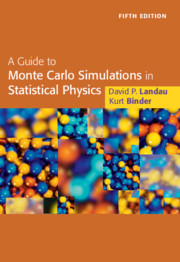Book contents
- A Guide to Monte Carlo Simulations in Statistical Physics
- A Guide to Monte Carlo Simulations in Statistical Physics
- Copyright page
- Contents
- Preface
- 1 Introduction
- 2 Some necessary background
- 3 Simple sampling Monte Carlo methods
- 4 Importance sampling Monte Carlo methods
- 5 More on importance sampling Monte Carlo methods for lattice systems
- 6 Off-lattice models
- 7 Reweighting methods
- 8 Quantum Monte Carlo methods
- 9 Monte Carlo renormalization group methods
- 10 Non-equilibrium and irreversible processes
- 11 Lattice gauge models: a brief introduction
- 12 A brief review of other methods of computer simulation
- 13 Monte Carlo simulations at the periphery of physics and beyond
- 14 Monte Carlo studies of biological molecules
- 15 Emerging trends
- Index
- References
3 - Simple sampling Monte Carlo methods
Published online by Cambridge University Press: 24 November 2021
- A Guide to Monte Carlo Simulations in Statistical Physics
- A Guide to Monte Carlo Simulations in Statistical Physics
- Copyright page
- Contents
- Preface
- 1 Introduction
- 2 Some necessary background
- 3 Simple sampling Monte Carlo methods
- 4 Importance sampling Monte Carlo methods
- 5 More on importance sampling Monte Carlo methods for lattice systems
- 6 Off-lattice models
- 7 Reweighting methods
- 8 Quantum Monte Carlo methods
- 9 Monte Carlo renormalization group methods
- 10 Non-equilibrium and irreversible processes
- 11 Lattice gauge models: a brief introduction
- 12 A brief review of other methods of computer simulation
- 13 Monte Carlo simulations at the periphery of physics and beyond
- 14 Monte Carlo studies of biological molecules
- 15 Emerging trends
- Index
- References
Summary
Modern Monte Carlo methods have their roots in the 1940s when Fermi, Ulam, von Neumann, Metropolis, and others began considering the use of random numbers to examine different problems in physics from a stochastic perspective (Cooper, 1989); this set of biographical articles about S. Ulam provides fascinating insight into the early development of the Monte Carlo method, even before the advent of the modern computer. Very simple Monte Carlo methods were devised to provide a means to estimate answers to analytically intractable problems. Much of this work is unpublished and a view of the origins of Monte Carlo methods can best be obtained through examination of published correspondence and historical narratives. Although many of the topics which will be covered in this book deal with more complex Monte Carlo methods which are tailored explicitly for use in statistical physics, many of the early, simple techniques retain their importance because of the dramatic increase in accessible computing power which has taken place during the last two decades. In the remainder of this chapter we shall consider the application of simple Monte Carlo methods to a broad spectrum of interesting problems.
Information
- Type
- Chapter
- Information
- Publisher: Cambridge University PressPrint publication year: 2021
